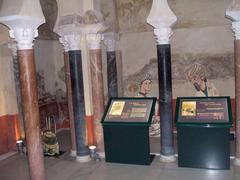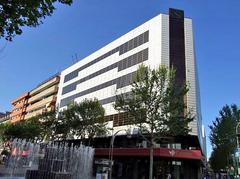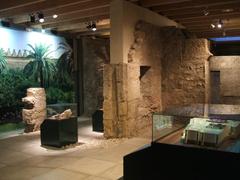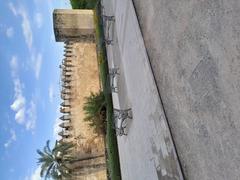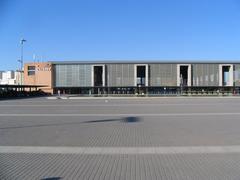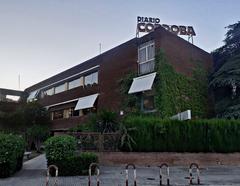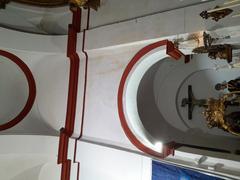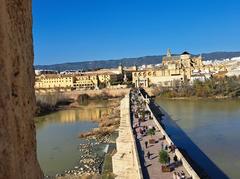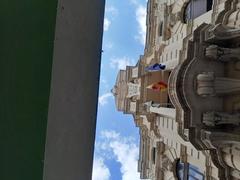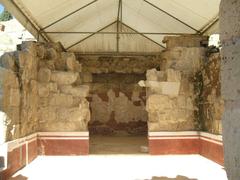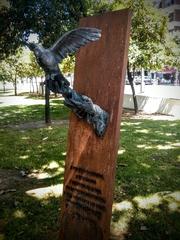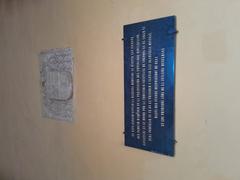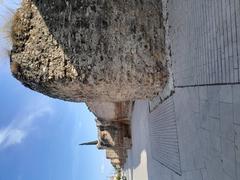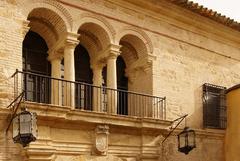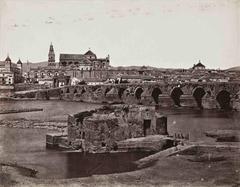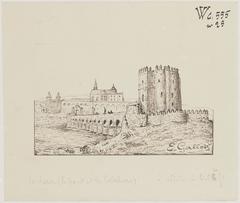Palacete de los Burgos: Visitor Guide, Tickets, and Historical Insights in Córdoba
Date: 14/06/2025
Introduction
The Palacete de los Burgos, set within Córdoba’s UNESCO-listed historic center, is a striking 19th-century mansion emblematic of the city’s architectural and cultural evolution. While currently closed for rehabilitation—soon to become a luxury hotel—its neoclassical and Andalusian features, such as whitewashed stucco, wrought-iron balconies, and a central patio, offer a tangible link to Córdoba’s layered past. This guide provides a comprehensive overview for travelers interested in the Palacete de los Burgos and Córdoba’s historic sites, including historical context, architectural highlights, practical visiting information, and recommendations for exploring the surrounding urban heritage (UNESCO World Heritage Centre; Mezquita-Catedral de Córdoba).
Contents
- Historical Context of Córdoba and the Palacete de los Burgos
- Architectural Features and Preservation
- Heritage Protection and Adaptive Reuse
- Visiting Information: Hours, Tickets, and Accessibility
- Nearby Attractions, Itineraries, and Tips
- Córdoba’s Patio Tradition and Cultural Significance
- Frequently Asked Questions (FAQ)
- Conclusion and Recommendations
- References
Historical Context of Córdoba and the Palacete de los Burgos
Roman and Visigothic Roots
Córdoba’s urban structure originated in Roman times, evident in the Puente Romano and the city’s grid. The Visigothic period added early Christian elements, such as the basilica of San Vicente (UNESCO World Heritage Centre; Mezquita-Catedral de Córdoba).
Islamic Golden Age and Urban Expansion
From the 8th century, Córdoba flourished as the capital of Al-Andalus, with iconic monuments like the Great Mosque (Mezquita) and an urban fabric characterized by winding streets and casa-patios—design elements that later influenced mansions such as the Palacete de los Burgos (UNESCO World Heritage Centre).
Christian Reconquest and Architectural Synthesis
After 1236, the Christian reconquest introduced Gothic, Renaissance, and Baroque styles. The palacete reflects this synthesis, with features such as central patios and Mudéjar motifs, blending the city’s multicultural heritage.
18th–19th Century Urban Development
The 19th century saw expansion beyond Córdoba’s medieval walls and the rise of neoclassical architecture. The Palacete de los Burgos, built during this period, became a symbol of the bourgeois elite and urban transformation (Wanderlust Photos Blog).
Preservation and Modern Urban Context
Since 1994, Córdoba’s historic center—including the palacete’s neighborhood—has been a UNESCO World Heritage Site, ensuring the preservation of its urban fabric and historic landmarks (UNESCO World Heritage Centre).
Architectural Features and Preservation
Facade and Exterior
The palacete’s facade unites neoclassical symmetry with regional Andalusian traits: whitewashed walls, finely carved stone surrounds, and wrought-iron balconies. Its harmonious integration with Plaza de Jerónimo Páez preserves the area’s visual identity.
Interior Layout
While the interior is currently inaccessible, typical features include a U-shaped layout centered on a decorated patio, high ceilings, a grand staircase, and detailed plasterwork—elements blending neoclassical and Mudéjar influences.
Construction Materials
Traditional elements such as thick masonry, timber beams, ceramic tiles, and artisanal ironwork create a sustainable and authentic architectural expression.
Heritage Protection and Adaptive Reuse
The Palacete de los Burgos is protected under Córdoba’s heritage regulations and the Plan Especial de Protección del Conjunto Histórico de Córdoba (PEPCHC). Its transformation into a luxury hotel is subject to strict oversight, ensuring preservation of its original features and historic fabric while adapting sensitively for modern use (Mercer Hoteles; Puerta de los Patios).
Visiting Information: Hours, Tickets, and Accessibility
Current Status (as of June 2025)
- Public Access: The Palacete de los Burgos is closed to the public due to ongoing rehabilitation. No regular visiting hours or ticket sales are available.
- Special Events: Occasional public access may be granted during local festivals such as the Fiesta de los Patios. Check with Córdoba Tourism Office or Mercer Hoteles for updates.
- Viewing: Visitors can admire the palacete’s exterior from Plaza de Jerónimo Páez and Calle Julio Romero de Torres. The surrounding area offers excellent photo opportunities.
Accessibility
- Exterior: Accessible from public streets.
- Interior: Currently closed; future accessibility will depend on hotel adaptation and heritage guidelines.
- Mobility: The historic center’s cobblestone streets may challenge visitors with reduced mobility.
Nearby Attractions, Itineraries, and Tips
Key Nearby Sites
- Mezquita-Catedral de Córdoba: Iconic mosque-cathedral (Mezquita-Catedral de Córdoba)
- Alcázar de los Reyes Cristianos: Fortress-palace with gardens (Artencordoba)
- Museo Julio Romero de Torres: Art museum on the same street (Explored by Marta)
- Patios of Córdoba: Visitable during the annual festival (Bea Adventurous)
Suggested Itinerary
Combine visits to the Mezquita, Jewish Quarter, and local museums with an exterior tour of the Palacete de los Burgos. Enjoy traditional Cordoban cuisine at nearby tabernas.
Practical Tips
- Dress Comfortably: Lightweight clothing and sun protection are essential, especially in summer (GoNOMAD).
- Language: Most signage and staff communicate in Spanish; translation apps can be helpful.
- Respect Private Property: The palacete is not open; do not attempt unauthorized entry.
Córdoba’s Patio Tradition and Cultural Significance
Córdoba’s patios, originating in Roman and Islamic times, are central to its social and architectural identity (tocordoba.com). The tradition is celebrated each May during the Festival de los Patios Cordobeses, a UNESCO-recognized event (Explorial). Patios are adorned with flowers, fountains, and intricate tilework—features echoed in the design of the Palacete de los Burgos.
The ongoing involvement of local residents and associations ensures the survival of these traditions, contributing to the city’s living heritage.
Frequently Asked Questions (FAQ)
Q: Can I visit the Palacete de los Burgos now?
A: No, the palacete is closed for redevelopment. Exterior views are accessible; interior access may resume after hotel conversion.
Q: Are there guided tours or special events?
A: Occasionally, during festivals or special open days. Check with Puerta de los Patios or Córdoba Tourism Office.
Q: Is the site wheelchair accessible?
A: The exterior is accessible from public streets. Future interior access and accessibility will depend on hotel adaptations.
Q: What is the best way to experience Córdoba’s patios?
A: Attend the Festival de los Patios in May or visit public patios like those at Palacio de Viana (tocordoba.com).
Conclusion and Recommendations
The Palacete de los Burgos is a remarkable testament to Córdoba’s rich architectural tapestry and evolving urban history. Although currently closed, it remains a key landmark for understanding the city’s 19th-century transformation and enduring patio tradition. Complement your visit by exploring nearby historical sites and engaging with Córdoba’s vibrant cultural life. Stay informed about access and events via official tourism resources and consider planning your trip around local festivals for unique experiences.
For up-to-date information, visit the Córdoba Tourism Office, Mercer Hoteles, and Puerta de los Patios. Download the Audiala app for interactive tours and navigation, and follow our channels for the latest news on Córdoba’s heritage.
References
- UNESCO World Heritage Centre
- Mezquita-Catedral de Córdoba
- Wanderlust Photos Blog
- Puerta de los Patios
- Turismo de Córdoba
- Explorial
- tocordoba.com
- Mercer Hoteles
- Explored by Marta
- Artencordoba
- Bea Adventurous
- GoNOMAD
